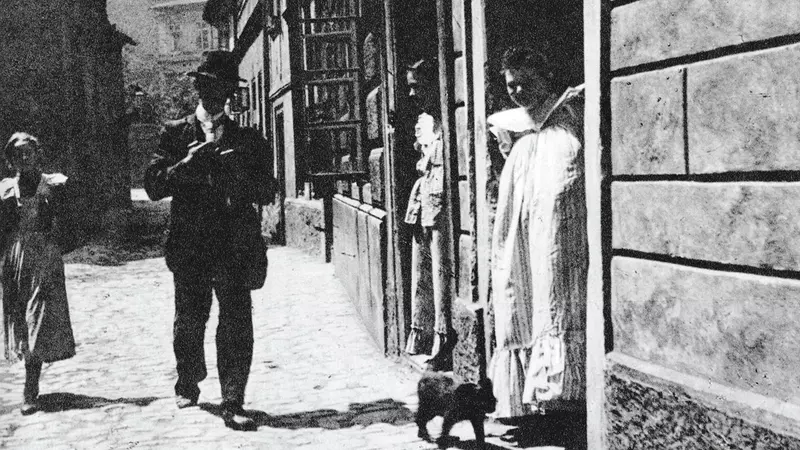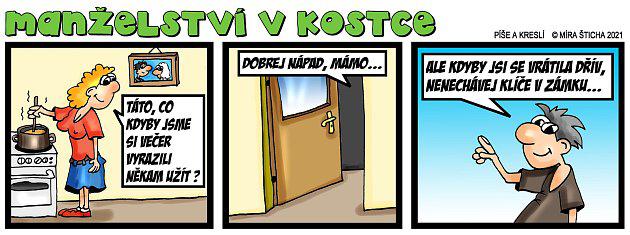Among the prostitutes were dancers and clerks<
It should be noted that the word fuck did not sound as derogatory in the past as it does today. Josef Jungmann used the same characteristic more than two centuries later. The word prostitute was taken over by modern Czech from French.
It was in the 16th century that prostitution associated with pimping only flourished. She was not overcome by syphilis, which was also called French disease, which appeared in the late 15th century in Naples.
In the Czech lands, the operation of the oldest craft was punished quite slightly - suspended sentences, beatings, fines, dismissals. The same was true for pimps, who took at least a third of their earnings from girls. And they also treated them miserably.
It's worse in her house than in hell
In the 16th century in Prague, a certain Knobloška beat the prostitutes, spat on them and confiscated their clothes so that they would not run away. Prostitutes publicly complained about her, lamenting that "her house is worse than hell except she doesn't burn." The knoblosk ended up miserable - in 1587 she was drowned by an executioner for her inhuman actions. And the light maids continued to work merrily.
Prostitution was most successful in cities, where public houses were invited to visit, as well as hammershops and "empty women", which attracted customers, for example, in Prague to heaps of wood on the Vltava bank.
Illegal brothels for the rich originated in the capital Na Františku, in Celetná Street, in Podskalí. At the end of the 15th century, Bohuslav Hasištejnský sighed: "All almost contemporaries are looking for prostitutes." Even married prostitutes.
Vostudu committed
In March 1603, neighbors complained about Maruška, the wife of Martin Wildernist, from Kaprova Street. She accepted clients in the apartment who came to her on horseback, made noise and "committed". This irritated the townspeople because: "they threw them into the window to Maruška to let them go, and she threw them down again. They told her to let them go, that she was their whore. " Maruška was fined for disturbing the peace.
After Prague, prostitution flourished in the mining and mint Kutná Hora, where after the Thirty Years' War, prostitutes had to sweep the streets and export dirt. In the 18th century, public works were added.
In the Habsburg monarchy, Maria Theresa tried to "clean up" the streets (Milena Lenderová dealt with the issue of modern prostitution in her book Catching a Patrol or Prostitution for Austria and the Republic, Karolinum 2002).
Wounded, beaten and testified
Maria Theresa set up the Chastity Commission (Keuschheitskomission) headed by the Jesuit Panhammer. She worked for the moral police and had the couple catch up in flagranti. The prostitutes were vilified, beaten and fired. They also cut their hair.
Joseph II he was also a very rational ruler in this respect - he abolished the commission and the number of prostitutes did not increase significantly. There were 15,000 of them in Vienna.
In 1787, the Faculty of Medicine of the University of Vienna and the Police Directorate proposed that all areas where prostitutes work should be subject to police and medical supervision. Sober Joseph II. he said: "In that case, it would be necessary to build a roof over the whole world."
Prostitution was then dealt with in a law of 1803, which also targeted women "affected by the French and yet a business leader." You could get up to three months in prison. Even the 19th century did not slow down prostitution.

A bitch with cataracts on her eye
"Franta took us to a public house, where an elderly whore with cataract greeted me almost in a feverish trembling," said future historian Josef Šusta, describing his first visit to the brothel in 1887. , I was so disgusted that not only did I run away from the den, leaving my hat there, but my stomach burst into the street just like I had the first time I smoked. ”
The bridesmaids were consistently condemned by the writer, journalist and politician Josef Václav Frič, who advised young men to find "a way other than that offered by brothels, namely to find a permanent mistress." He mentioned his own in his Memoirs - she was a young London widow.
When the writer Teréza Nováková, among others also a supporter of the women's emancipation movement, read the work just quoted, the passage about her lover upset her so much that she put the book aside.
However, prostitution in the 19th century flourished as well as in earlier times. And with all the related scandals.
They were all to the butcher
In 1856, a certain butcher in the brothel of Adolf Groll in Prague made a big mistake. After his satisfaction, he said of one of the girls that she was an old masquerade and a box, in short, a worn fuck and a shabby cable. And he shouldn't have done that.
The brides pounced on him, and including the co-owner of the company, Matilda Groll, “they all beat the butcher only. The master suffered minor injuries, brandishing a beer pipe around him. " The mystery remained how a beer pipe got into the brothel, where no alcohol was officially served.
There were many similar excesses. From the Middle Ages until 1922, when the law on the control of sexually transmitted diseases was passed, prostitution was divided into bar, brothel and wandering. Wandering was subject to the fluctuations of the seasons. In the winter, it was difficult to stand on the streets, but the spring was as done for prostitution. This was also confirmed by Jan Neruda, because "at that time also the time of rich or new clothes is coming and girls are born out of vanity". But even vanity cost effort.
Come warm your feet!
In the warm June, the streets were already full of girls, and their shouts such as "Handsome, come warm your feet!" And "Do you have a cigarette?" Echoed cheerfully over the sidewalks. Most girls pedaled in Prague in the Jewish quarter, in Kožná and Železná streets, in Kamzíková, around the Old Town Square, in Malá Strana, near the church of St. Haštala and Na Františku. There were also the poorest champignons - for example, in Kožná Mastný bun, named after the owner's unattractive hairstyle, and there stinking room - a brothel called aptly Fucked.
In similar establishments, on the street and in taverns, relatively older light ladies usually worked, who already had a lot behind them. Many boasted of their business knowledge as the Viennese prostitute Josefina Mutzenbacher: “I became a light girl very early and did everything a woman can do in bed, on a table, on a chair, on a bench, in the grass, on a train or in prison. "
The girls also loved one-hour hotels and rented apartments. The nicer and younger ones moved to public homes, where they lived more comfortably. And also more expensive.
May God bless us
"There used to be a brothel in Platnéřská Street, in the room of which hung a sign above the door with the saying Our God's Blessing, and on the window there was a sign with the words Soda Water by Dra Zátka," recalled journalist Karel Ladislav Kukla.
According to the Prague police, there were thirty licensed brothels with 82 prostitutes in Prague in 1866. By 1920, there were 305 brothels with 706 "inmates". They were better in the houses of dignified Prague citizens - among others in the family of the merchant Rott.
They had their own categories - in Prague, the brothel at Goldschmiedů in Kamzíková Street, at Kautského in Platnéřská or at Radecký in Rybná was one of the most famous luxuries. Life in them was governed by precise rules and it was no fun to lead them.
The owner had to have a concession and respect the Trade Act of 1885. According to him, the serving of spirits in the public house was forbidden, but many brothels received an inn concession due to good contacts with the police. The everyday life in them was almost boring.
Almost family life
“The house was whole for pleasure very nicely and tastefully decorated. She had a kind of cabinet or room in it, so mirrored by the mirrors themselves, "the witness described the public house of Mrs. Fleklová in Kaprova Street in Prague.
There used to be a sink and a dressing table in luxury brothels. The women took a bath at eleven in the morning, then ate breakfast in the negligee. Only then did they adjust, smoke, play cards, read. They had lunch late, mostly at three, and together. "There was a double plate on each table, a napkin in a circle, and silverware next to it."
Lunch was chaired by Madame. The "shift" started at eight. The girls led almost family life. They were secured and received gifts for Christmas. They served three to five customers a day. They could earn 1,000 to 1,100 gold coins a year, of which they paid for food, heating, cleaning and linen. In addition, they received money for stockings.
For comparison - the clerk had 600 gold per year, the professor at the school 950, the industrial teacher 200 gold. Although the earnings were decent, woe as the prostitute grew old, thickened or lost weight. She ended up on the street, in a bar or as a beggar.
Dancers and educators
The prostitutes came from all walks of life. Photographs of 19th-century prostitutes said nothing about their profession. White blouses with lace up to the neck, hats, small jewelry. Girls fat, skinny, slim. Fawn, dark-haired, red-haired, as anyone wished. They were chubby in popularity. They were waitresses, educators, clerks, maids. Girls from good families were often "crafted" so that they "wouldn't have to work, just dance, have nice clothes and gold rings."
One of the "girls" expressed it succinctly. She said, "Well, our constitutions aren't the worst, they seem better than the serfdom in the factory."


 Tags:
Tags:







